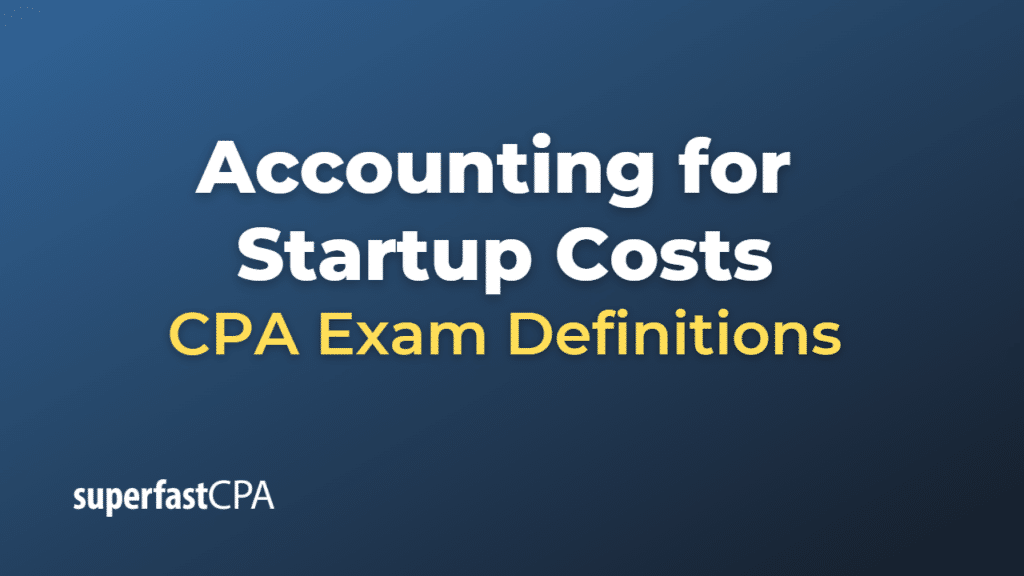Accounting for Startup Costs
Accounting for startup costs involves the identification, recognition, measurement, and disclosure of the expenses a company incurs during the initial stages of its operations. Startup costs can include expenses such as legal fees, registration fees, pre-opening advertising, employee training, rent deposits, and other costs incurred before the company starts generating revenue.
Under U.S. Generally Accepted Accounting Principles (GAAP), accounting for startup costs is primarily governed by the Financial Accounting Standards Board (FASB) Accounting Standards Codification (ASC) Topic 720-15, “Startup Activities.
Here are the key aspects of accounting for startup costs:
- Identification: Determine if a cost qualifies as a startup cost. Startup costs are the expenses incurred in the initial stages of a company’s operations before it begins generating revenue.
- Recognition: Under GAAP, startup costs should be recognized as expenses in the income statement when they are incurred, rather than capitalized as assets. This is in accordance with the accrual basis of accounting and the matching principle, which requires that expenses be recognized in the same period as the revenues they help generate. Since startup costs are not directly associated with generating revenues, they should be expensed as incurred.
- Measurement: Startup costs should be recorded at their actual amounts, which include the costs of materials, labor, and any related overheads.
- Presentation: Startup costs are typically presented as a separate line item in the income statement, often under operating expenses or as part of general and administrative expenses.
- Disclosure: Companies should provide clear and concise information about their accounting policies for startup costs in the notes to the financial statements. This may include the nature of the startup costs, the period in which they were incurred, and the company’s policy for recognizing such costs.
By properly accounting for startup costs, a company provides users of its financial statements with an accurate representation of its financial position and performance during the initial stages of its operations, considering the expenses necessary to establish the business and prepare it for revenue generation.
Example of Accounting for Startup Costs
Let’s consider an example of a company accounting for startup costs.
Example: Company XYZ is a new software development company that incurs the following startup costs before it begins generating revenue:
- Legal and registration fees: $5,000
- Office rent deposit: $10,000
- Pre-opening advertising: $4,000
- Employee training: $3,000
- Office equipment and furniture: $8,000
Here’s how Company XYZ would account for the startup costs:
Step 1:
Identification: Costs 1-4 qualify as startup costs, as they are incurred during the initial stages of the company’s operations before it starts generating revenue. Cost 5 is a capital expenditure for purchasing long-term assets (office equipment and furniture).
Step 2:
Recognition: Company XYZ recognizes the startup costs as expenses in the income statement when they are incurred, as follows:
| Legal and registration fees: | $5,000 |
| Office rent deposit: | $10,000 |
| Pre-opening advertising: | $4,000 |
| Employee training: | $3,000 |
| Total startup costs: | $22,000 |
Company XYZ capitalizes the cost of the office equipment and furniture as an asset in the balance sheet:
| Office equipment and furniture: $8,000 |
Step 3:
Measurement: Startup costs are recorded at their actual amounts.
Step 4:
Presentation: Company XYZ presents the startup costs as a separate line item in the income statement, often under operating expenses or as part of general and administrative expenses.
| Startup costs: $22,000 |
Step 5:
Disclosure: Company XYZ provides information about its accounting policies for startup costs in the notes to the financial statements, including the nature of the startup costs, the period in which they were incurred, and the company’s policy for recognizing such costs.
By properly accounting for startup costs, Company XYZ provides users of its financial statements with an accurate representation of its financial position and performance during the initial stages of its operations, considering the expenses necessary to establish the business and prepare it for revenue generation.













